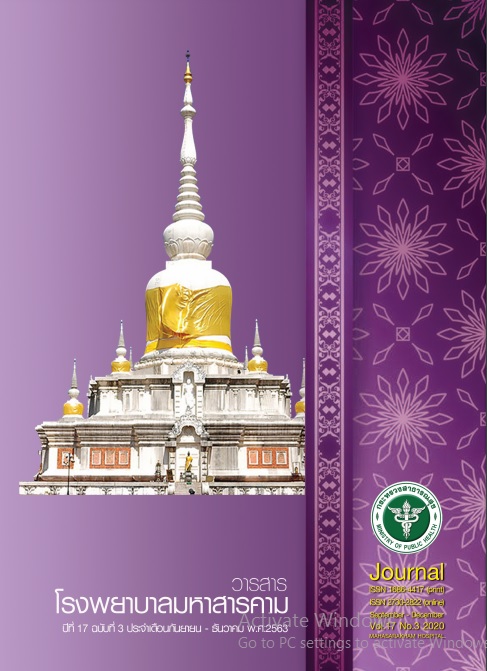การลดภาวะเลือดออกจากโพรงจมูกขณะใส่ท่อช่วยหายใจทางจมูกด้วยการนำทางโดยใช้สายดูดเสมหะ
คำสำคัญ:
NASOTRACHEAL INTUBATION, GUIDING CATHETER, EPISTAXISบทคัดย่อ
DOES SUCTION TUBE GUIDING REDUCE EPISTAXIS FROM NASOTRACHEAL INTUBATION?
Isara Jongcharoenkamon MD., Tanatorn Juajarn MD., Nipawan Pisilp RN.
Department of Anesthesiology, Maharatnakhonrajasima hospital
Background: Epistaxis is a common complication of nasotracheal intubation that lead to more difficult to proceed intubation. Guiding catheter pass nasopharynx can reduce false tract and impingement of nasopharynx area that lead to epistaxis. Suction tube is an equipment that we always prepare for intubation, so no more cost needed to use it as the catheter tube.
Methods: A Randomized controlled trial study, compare nasotracheal intubation with suction tube guiding to conventional technique (blind insertion of tracheal tube through nasal cavity), primary outcome is incidence of epistaxis. secondary outcomes are grade of epistaxis, difficulty of nasopharynx insertion and numbers of attempt. Statistically significant was calculated by Fisher exact test
Results: 70 patients who need nasotracheal intubation to proceed the operation were randomized into two groups (suction guiding group and conventional group; 35 patients each). The incidence of epistaxis is no difference between suction guiding group and conventional group 11(31.43%) VS 16(45.71%)
(Risk ratio 0.68; 0.37-1.26). There was no severe bleeding in suction guiding group (0 VS 2). Difficulty score and number of attempts were statistically different between suction guiding group and conventional group; P-value=0.002 and 0.0473 consequencely.
Conclusion: Suction guiding nasotracheal intubation does not reduce the incidence of epistaxis but there was no severe bleeding in suction guiding group. It was easier in passing tracheal tube through nasopharynx by use suction tube guiding to perform nasotracheal intubation.
References
C.-W. Lim, S.-W. Min, C.-S. Kim,2 J.-E. Chang, J.-E. Park and J.-Y. Hwang ;The use of a nasogastric tube to facilitate nasotracheal intubation: a randomised controlled trial Anaesthesia 2014, 69, 591–597
Ogle OE, Weinstock RJ, Friedman E. Surgical anatomy of the nasal cavity and paranasal sinuses. Oral and Maxillofacial Surgery Clinics of North America 2012; 24: 155–66.
Ahmed-Nusrath A, Tong JL, Smith JE. Pathways through the nose for nasal intubation: a comparison of three endotracheal tubes. British Journal of Anaesthesia 2008; 100: 269– 74.
Dietmar Enk, MD, Anne M. Palmes, MD, Hugo Van Aken, MD, PhD, FRCA, FANZCA, and Martin Westphal, MD; Nasotracheal Intubation: A Simple and Effective Technique to Reduce Nasopharyngeal Trauma and Tube Contamination Anesth Analg 2002;95:1432–6
Elwood T, Stillions DM, Woo DW, et al. Nasotracheal intubation: a randomized trial of two methods. Anesthesiology 2002;96:51–3.
Kim YC, Lee SH, Noh GJ, et al. Thermosoftening treatment of the nasotracheal tube before intubation can reduce epistaxis and nasal damage. Anesth Analg 2000; 91: 698–701
Downloads
เผยแพร่แล้ว
How to Cite
ฉบับ
บท
License
วารสารนี้เป็นลิขสิทธิ์ของโรงพยาบาลมหาสารคาม





